Numerical Calculation and Experimental Study of the Axial Force of Aero Fuel Centrifugal Pumps
Abstract
1. Introduction
2. Numerical Simulation of Axial Force
2.1. Modeling and Meshing
2.2. Boundary Conditions and Solution Settings
2.3. Analysis of Numerical Calculation Results
3. Axial Force Measurement Test
3.1. Principle of Axial Force Testing
3.2. Analysis of Test Results
4. Theoretical Calculation Formula of Axial Force
4.1. Theoretical Formula Calculation
4.2. Calculation Method Modification
5. Conclusions
- The axial force of the centrifugal impeller accounts for the main part of the total axial force, while the axial force of the induction wheel is relatively small due to its weak pressurization ability. Under the condition of constant outlet throttling state, the axial force of the fuel centrifugal pump increases with the increase in the rotational speed and the slope of the curve also increases obviously in the process of increasing;
- The variation trend of the simulated axial force obtained by the numerical simulation method is roughly the same as that of the experimental value and the maximum error is 9.7%. The simulation method can accurately predict the axial force of an aero fuel centrifugal pump;
- The axial force of the centrifugal pump calculated by the traditional theoretical formula has a large error, while the error between the calculated value obtained by the modified formula and the experimental value is within 9.88%, indicating that the modified formula can accurately calculate the axial force of the fuel centrifugal pump.
Author Contributions
Funding
Institutional Review Board Statement
Informed Consent Statement
Data Availability Statement
Acknowledgments
Conflicts of Interest
References
- Zhang, N.; Gao, B.; Li, Z.; Ni, D.; Jiang, Q. Unsteady flow structure and its evolution in a low specific speed centrifugal pump measured by PIV. Exp. Therm. Fluid Sci. 2018, 9, 133–144. [Google Scholar] [CrossRef]
- Li, W.G. Effects of viscosity on turbine mode performance and flow of a low specific speed centrifugal pump. Appl. Math. Model. 2016, 40, 904–926. [Google Scholar] [CrossRef]
- Jafarzadeh, B.; Hajari, A.; Alishahi, M.; Akbari, M. The flow simulation of a low-specific-speed high-speed centrifugal pump. Appl. Math. Model. 2011, 35, 242–249. [Google Scholar] [CrossRef]
- Hou, H.; Zhang, Y.; Li, Z. A numerically research on energy loss evaluation in a centrifugal pump system based on local entropy production method. Therm. Sci. 2017, 21, 1287–1299. [Google Scholar] [CrossRef]
- Wang, C.; Shi, W.; Wang, X.; Jiang, X.; Yang, Y.; Li, W.; Zhou, L. Optimal design of multistage centrifugal pump based on the combined energy loss model and computational fluid dynamics. Appl. Energy 2017, 187, 10–26. [Google Scholar] [CrossRef]
- Zemanová, L.; Rudolf, P.; Zubík, P. Experimental investigation of flow inside the back-sidewall gaps of centrifugal pump and its impact on axial thrust. IOP Conf. Ser. Earth Environ. Sci. 2022, 1079, 012037. [Google Scholar] [CrossRef]
- Tan, M.; Yuan, S.; Liu, H.; Wang, Y.; Wang, K. Numerical research on performance prediction for centrifugal pumps. Chin. J. Mech. Eng. 2010, 23, 21–26. [Google Scholar] [CrossRef]
- Kalinichenko, P.; Shepil, O.; Velikodnyj, E. Effective ways of axial relief of a stage of the centrifugal pump and the compressor. Compress. Power Eng. Ind. 2007, 16, 79–81. [Google Scholar]
- Cheah, K.; Lee, T.; Winoto, S.; Zhao, Z. Numerical flow simulation in a centrifugal pump at design and off-design conditions. Int. J. Rotating Mach. 2007, 115, 342–350. [Google Scholar] [CrossRef]
- Huang, D.; Zhuang, Y.; Cai, R. A computational method for cavitational flows based on energy conservation. Proc. Inst. Mech. Eng. J. Mech. Eng. Sci. 2007, 221, 1333–1338. [Google Scholar] [CrossRef]
- Guo, M.; Liu, S.; Tang, X.L. Evaluation of shaft forces in a vertical canned motor through local hydraulic loss analysis. Adv. Mech. Eng. 2018, 3, 1–20. [Google Scholar] [CrossRef]
- Zhou, L.; Shi, W.; Li, W.; Agarwal, R. Numerical and experimental study of axial force and hydraulic performance in a deep-well centrifugal pump with different impeller rear shroud radius. J. Fluids Eng. 2013, 135, 104501. [Google Scholar] [CrossRef]
- Wang, C.; Shi, W.; Zhang, L. Calculation formula optimization and effect of ring clearance on axial force of multistage pump. Math. Probl. Engineering 2013, 2013, 749375. [Google Scholar] [CrossRef]
- Han, W.; Maa, W.; Li, R.; Li, Q. The numerical analysis of radial thrust and axial thrust in the screw centrifugal pump. Procedia Eng. 2012, 31, 176–181. [Google Scholar] [CrossRef]
- Pehlivan, H.; Parlak, Z. Investigation of parameters affecting axial load in an end suction centrifugal pump by numerical analysis. Appl. Fluid Mech. 2019, 12, 1615–1627. [Google Scholar] [CrossRef]
- Gantar, M.; Florjancic, D.; Sirok, B. Hydraulic axial thrust in multistage pumps-origins and solutions. J. Fluids Eng. 2002, 124, 336–341. [Google Scholar] [CrossRef]
- Mary, B.; Cerru, F. Axial force modelling and measurement in a single stage centrifugal pump. In Proceedings of the European Conference on Turbomachinery Fluid Dynamics and Thermodynamics, Lausanne Switzerland, 8–12 April 2019. [Google Scholar]
- Hernandez-Solis, A.; Carlsson, F. Diagnosis of submersible centrifugal pumps: A motor current and power signature approaches. Epe J. Power Electron. Drives 2010, 20, 58–64. [Google Scholar] [CrossRef]
- Kim, P.; Bae, S.; Seok, J. Resonant behaviors of a nonlinear cantilever beam with tip mass subject to an axial force and electrostatic excitation. Int. J. Mech. Sci. 2012, 64, 232–257. [Google Scholar] [CrossRef]
- Schaefer, S.; Olson, E. Experimental evaluation of axial thrust in pumps. World Pumps. 1999, 393, 34–37. [Google Scholar]
- Babayigit, O.; Ozgoren, M.; Aksoy, M.; Kocaaslan, O. Experimental and CFD investigation of a multistage centrifugal pump including leakages and balance holes. Desalin. Water Treat. 2017, 67, 28–40. [Google Scholar] [CrossRef]
- Dong, W.; Chu, W.; Liu, Z.L. Influences of the diameter of the balance hole on the flow characteristics in the hub cavity of the centrifugal pump. J. Hydrodyn. 2019, 31, 1060–1068. [Google Scholar] [CrossRef]
- Zhu, D.; Yao, Z.; Yang, W.; Liu, W. Optimization design for reducing the axial force of a vaned mixed-flow pump. Eng. Appl. Comput. Fluid Mech. 2020, 14, 882–896. [Google Scholar] [CrossRef]
- Cheng, X.; Chang, Z.; Jiang, Y. Study on the influence of the specific area of balance hole on cavitation performance of high-speed centrifugal pump. J. Mech. Sci. Technol. 2020, 34, 3325–3334. [Google Scholar] [CrossRef]
- Xia, B.; Kong, F.; Zhang, H. Investigation of axial thrust deviation between the theory and experiment for high-speed mine submersible pump. Adv. Mech. Eng. 2018, 10, 754356344. [Google Scholar] [CrossRef]
- Bruurs, K.; Van, B.; Van, M.S. Axial thrust prediction for a multi-stage centrifugal pump. In Proceedings of the Fluids Engineering Division Summer Meeting: American Society of Mechanical Engineers, Waikoloa, HI, USA, 30 July–3 August 2017. [Google Scholar]
- Spalart, P.; Shur, M. On the sensitization of turbulence models to rotation and curvature. Aerosp. Sci. Technol. 1997, 1, 297–302. [Google Scholar] [CrossRef]
- Feng, J.; Benra, F.; Dohmen, H. Application of different turbulence models in unsteady flow simulations of a radial diffuser pump. Forsch. Ingenieurwes. 2010, 3, 123–133. [Google Scholar] [CrossRef]
- Zhao, J.J.; Mu, J.G.; Zheng, S.H.; Lu, H.Q.; Wang, H. The impact of balance hole radial position of centrifugal pump on axial force and external characteristics. Appl. Mech. Mater. 2012, 130, 1691–1695. [Google Scholar] [CrossRef]
- Kalinichenko, P.; Suprun, A. Effective modes of axial balancing of centrifugal pump rotor. Procedia Eng. 2012, 39, 111–118. [Google Scholar] [CrossRef]
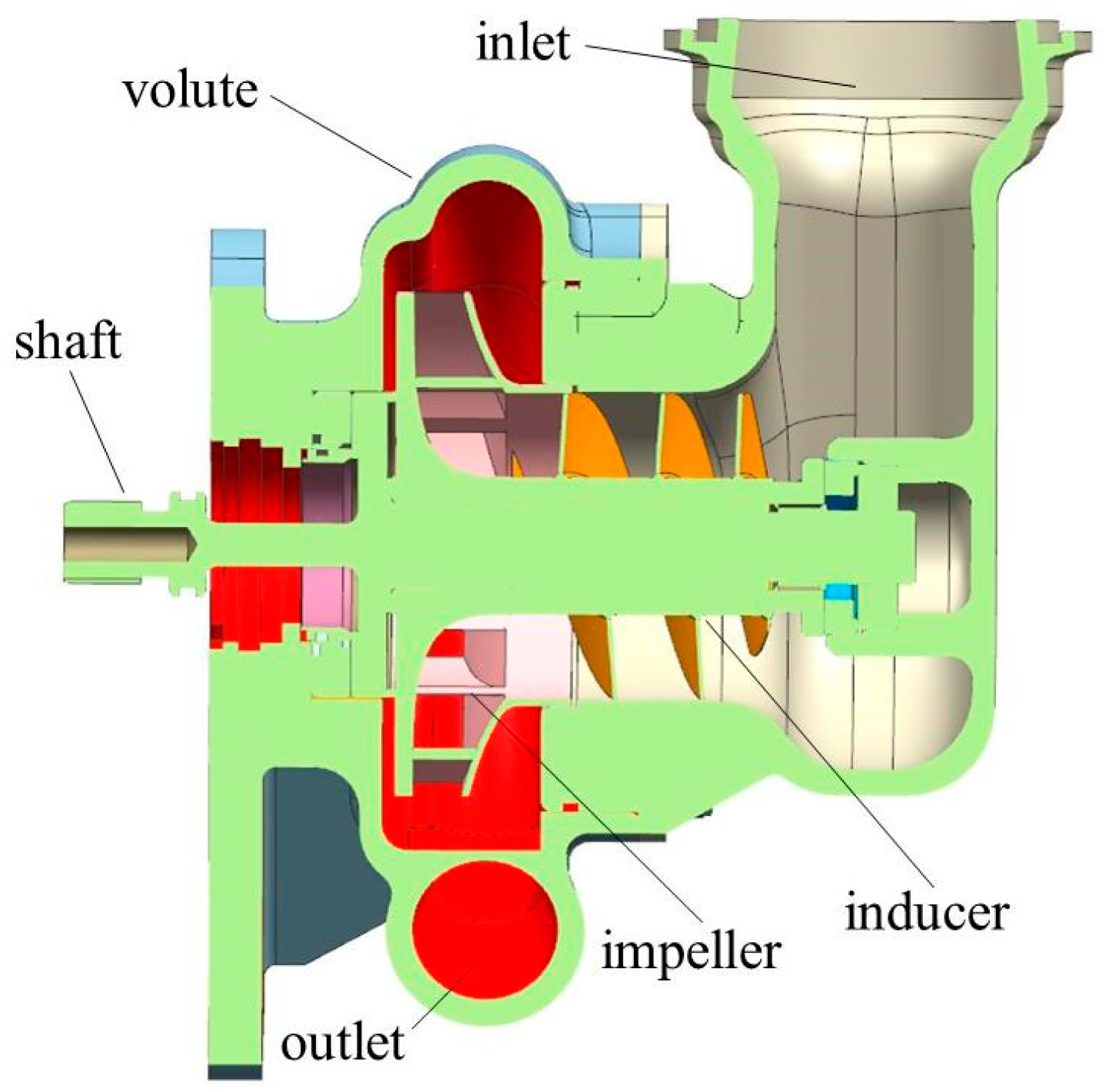

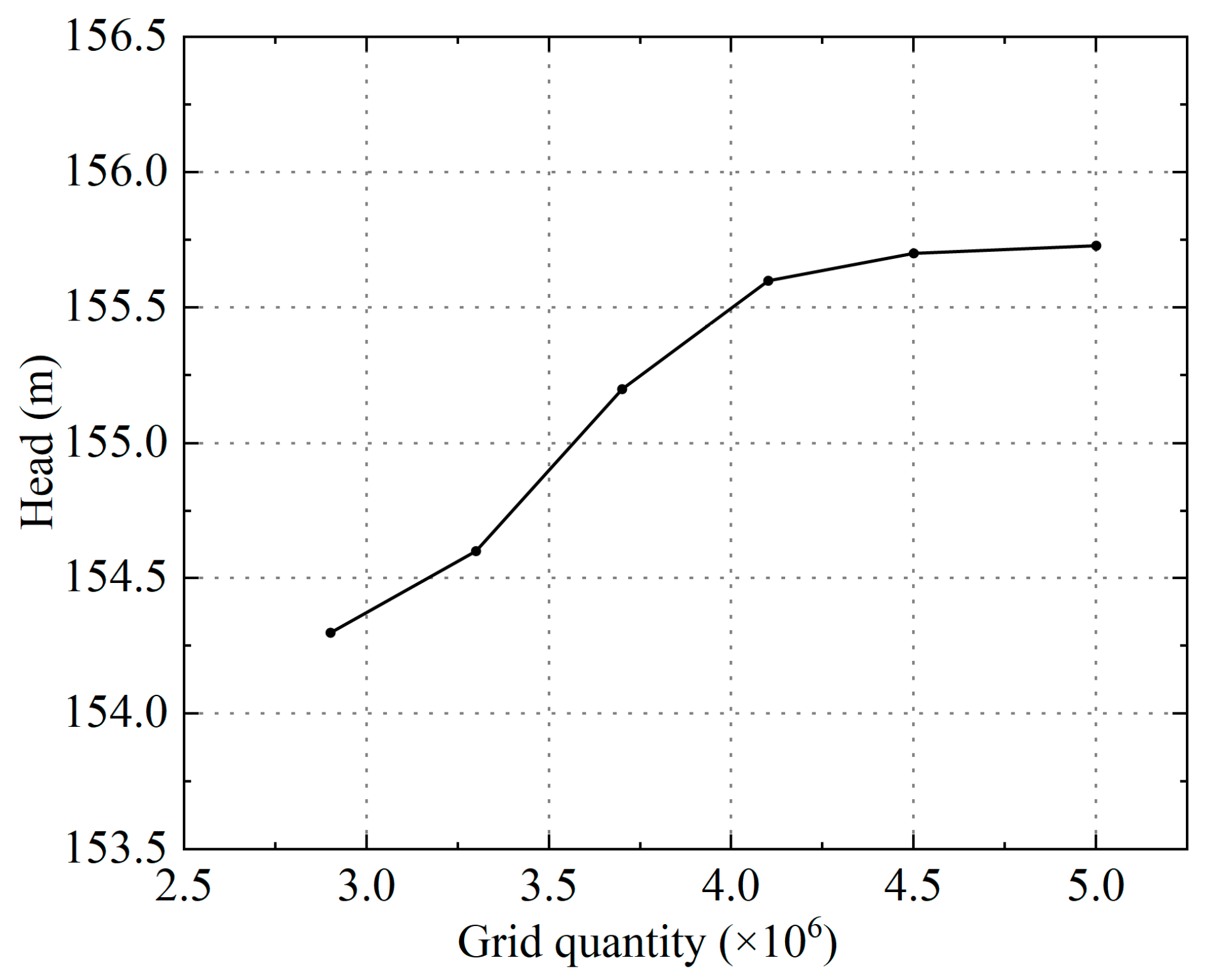
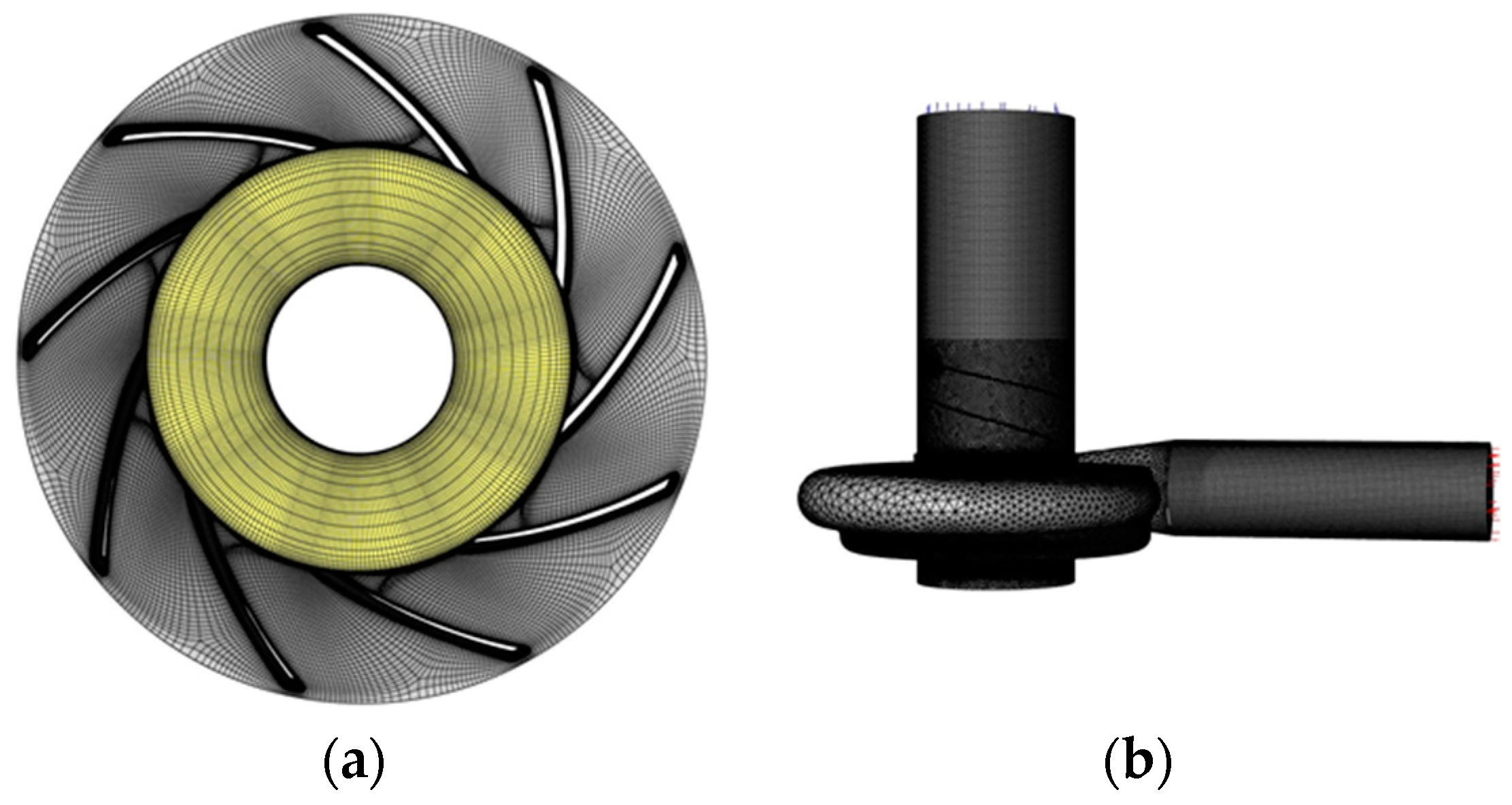
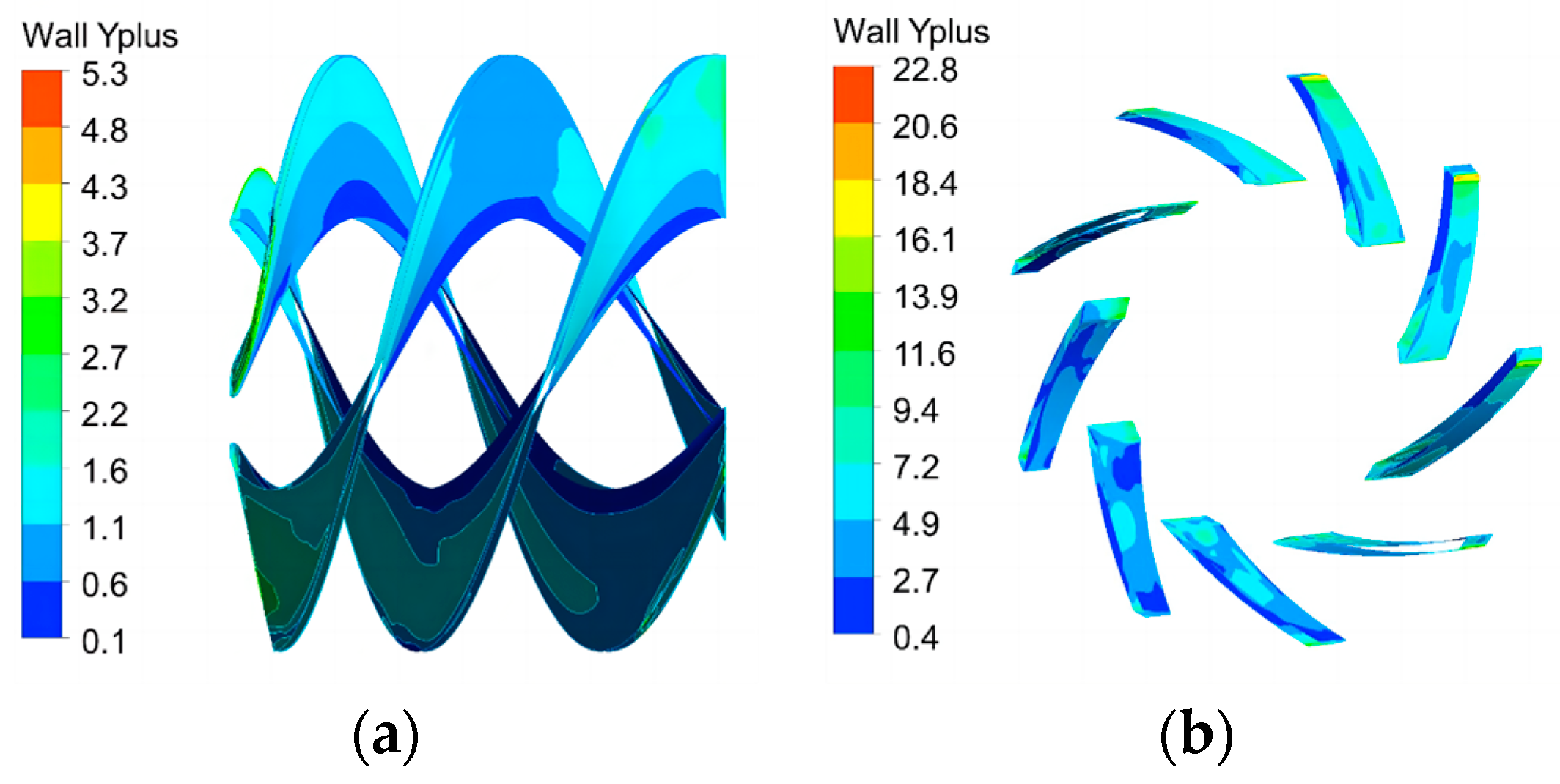

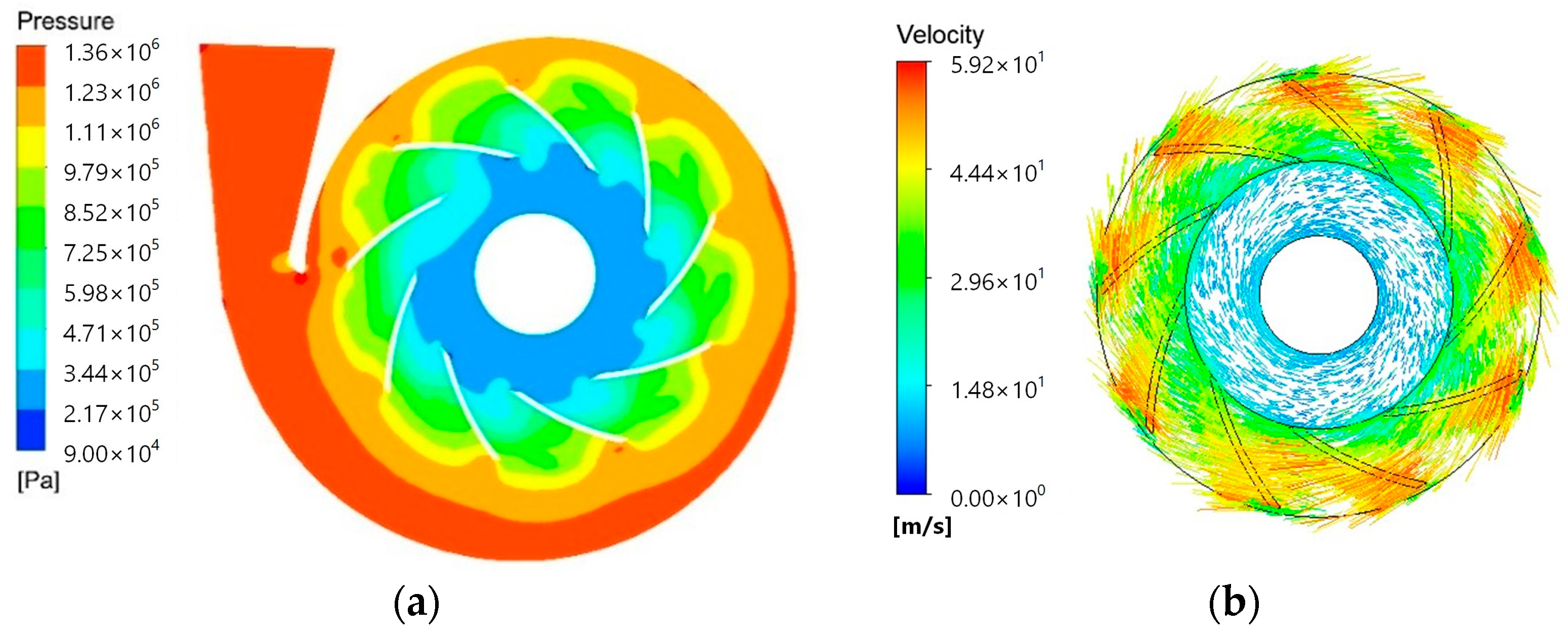
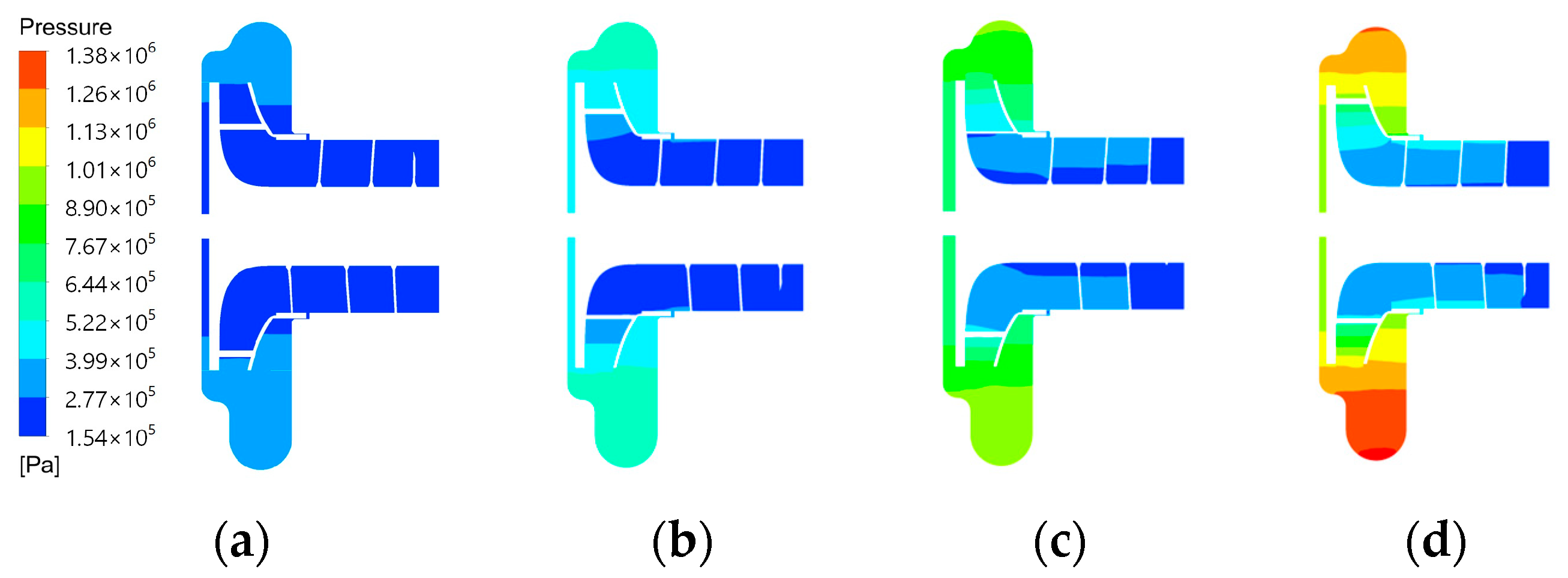


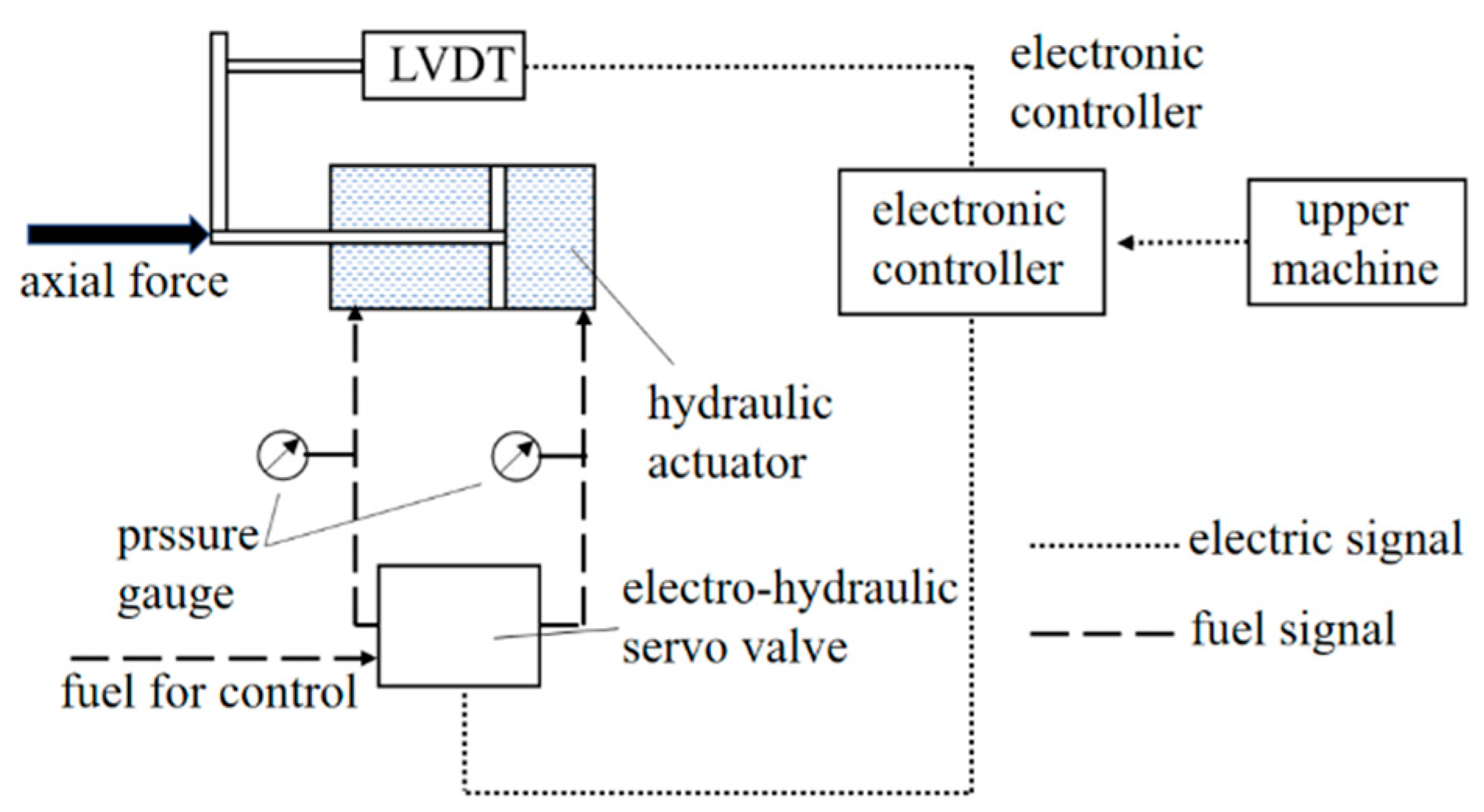
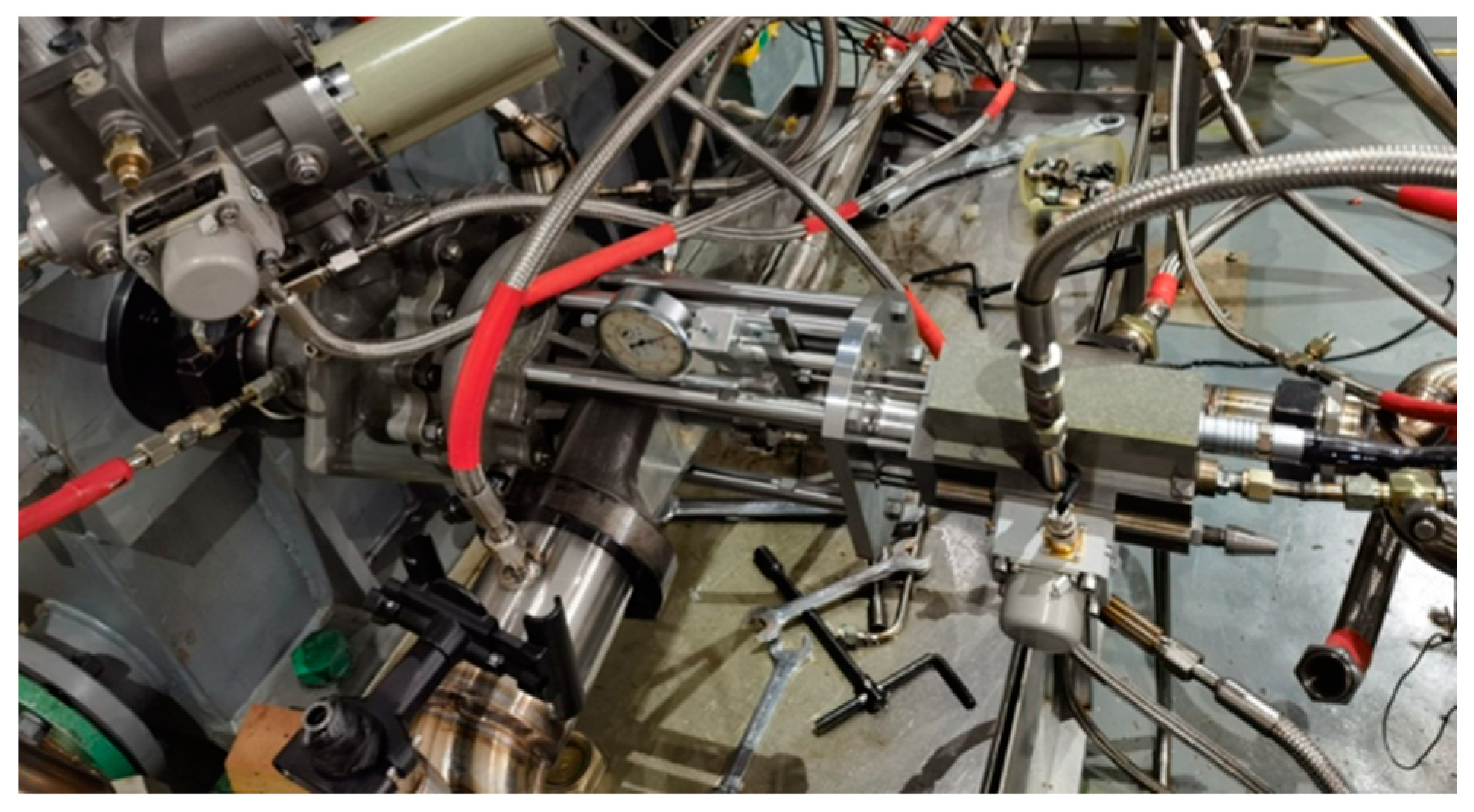
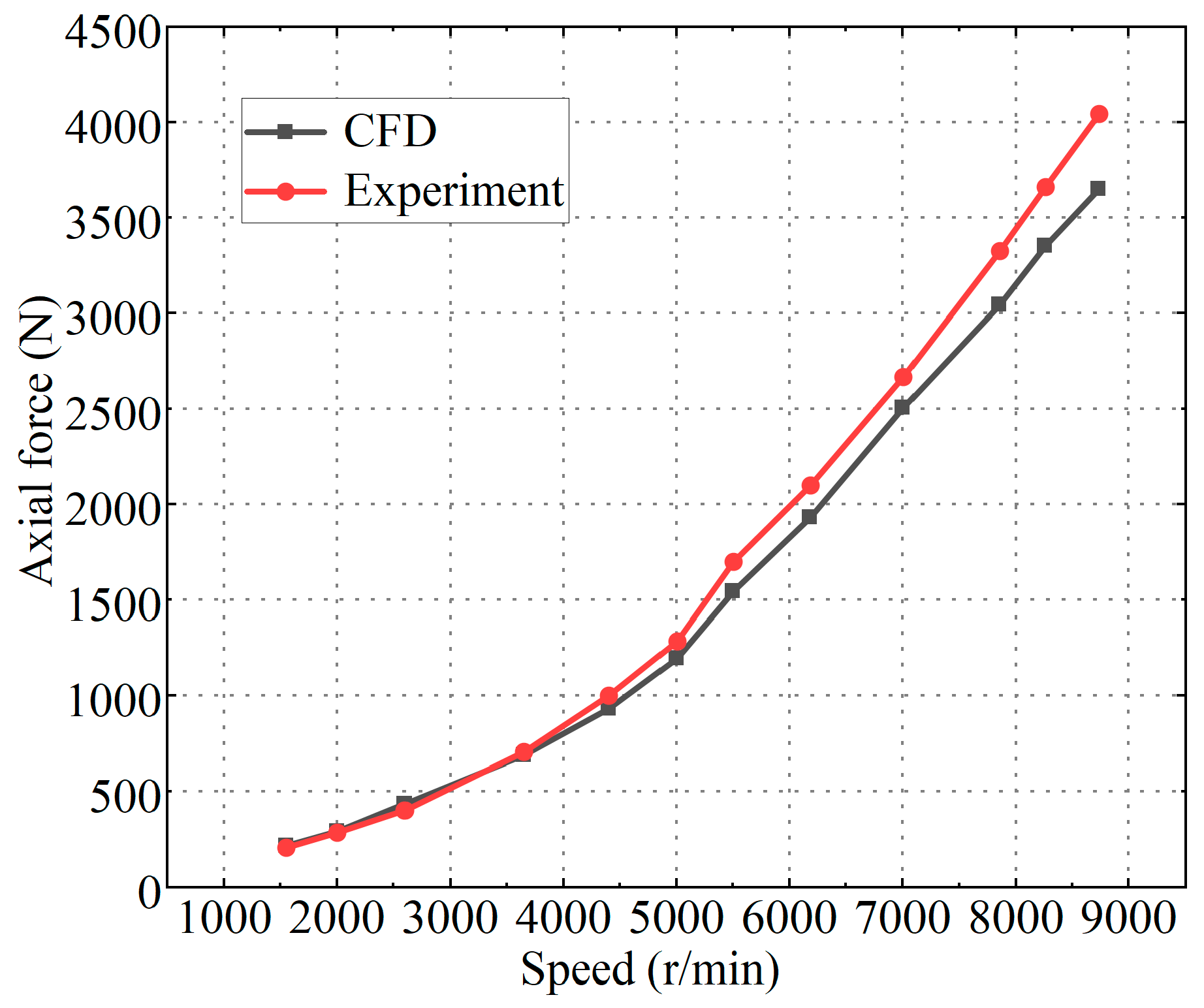
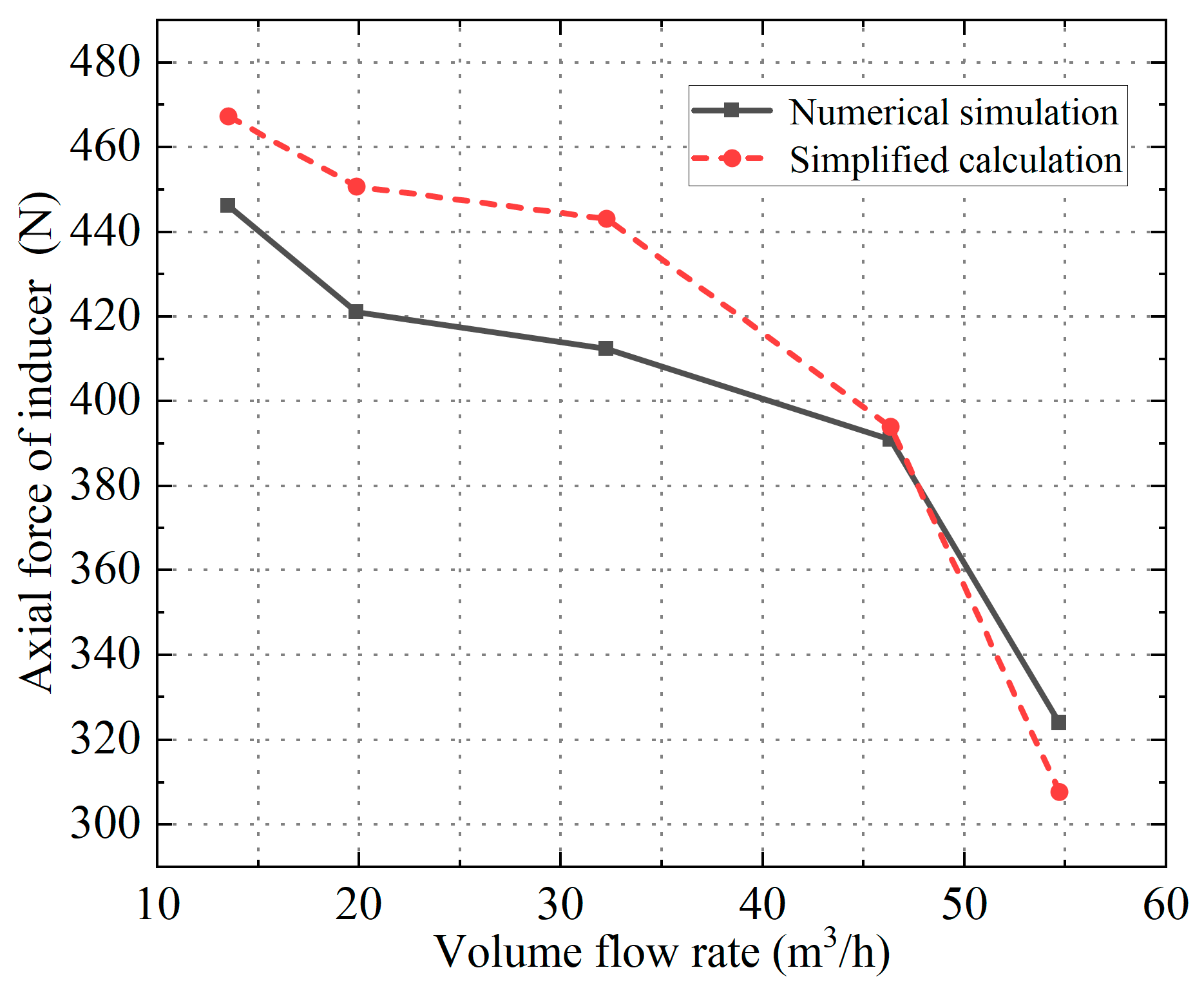
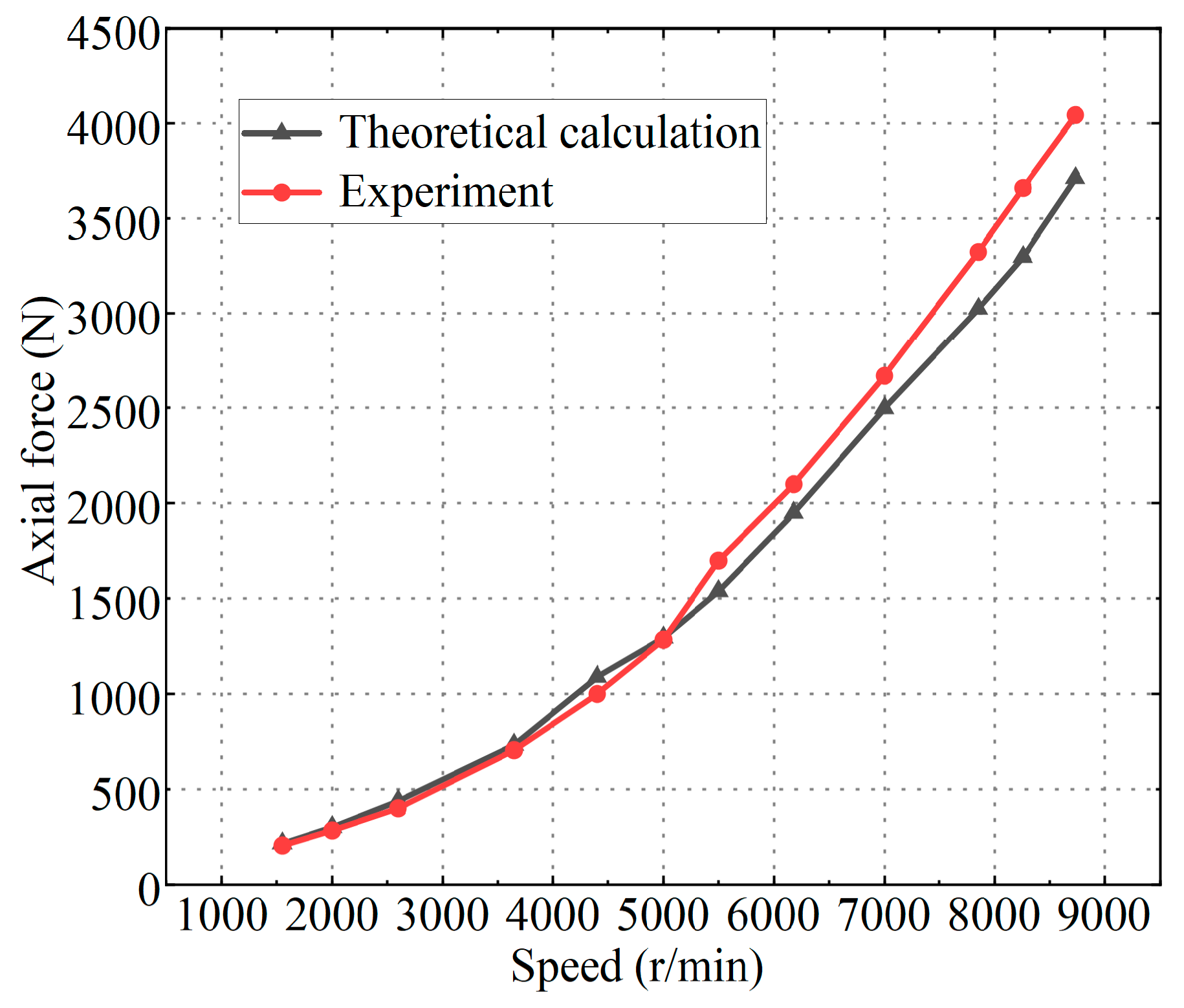
| Parameters | Value |
|---|---|
| Rated speed/(r/min) | 9000 |
| Maximum fuel flow/(kg/h) | 50,000 |
| Number of blades | 3 (Inducer), 9 (Impeller) |
| Inlet diameter of impeller/mm | 70.3 |
| Outer diameter of impeller/mm | 115 |
| k1 | k2 | k3 | k4 |
|---|---|---|---|
| 1.016 | 0.746 | 1.048 | 1.435 |
Disclaimer/Publisher’s Note: The statements, opinions and data contained in all publications are solely those of the individual author(s) and contributor(s) and not of MDPI and/or the editor(s). MDPI and/or the editor(s) disclaim responsibility for any injury to people or property resulting from any ideas, methods, instructions or products referred to in the content. |
© 2024 by the authors. Licensee MDPI, Basel, Switzerland. This article is an open access article distributed under the terms and conditions of the Creative Commons Attribution (CC BY) license (https://creativecommons.org/licenses/by/4.0/).
Share and Cite
Yan, S.; Kan, Y.; Li, X.; Xiao, L.; Ye, Z. Numerical Calculation and Experimental Study of the Axial Force of Aero Fuel Centrifugal Pumps. Appl. Sci. 2024, 14, 4313. https://doi.org/10.3390/app14104313
Yan S, Kan Y, Li X, Xiao L, Ye Z. Numerical Calculation and Experimental Study of the Axial Force of Aero Fuel Centrifugal Pumps. Applied Sciences. 2024; 14(10):4313. https://doi.org/10.3390/app14104313
Chicago/Turabian StyleYan, Shebin, Yinhui Kan, Xin Li, Lingfei Xiao, and Zhifeng Ye. 2024. "Numerical Calculation and Experimental Study of the Axial Force of Aero Fuel Centrifugal Pumps" Applied Sciences 14, no. 10: 4313. https://doi.org/10.3390/app14104313
APA StyleYan, S., Kan, Y., Li, X., Xiao, L., & Ye, Z. (2024). Numerical Calculation and Experimental Study of the Axial Force of Aero Fuel Centrifugal Pumps. Applied Sciences, 14(10), 4313. https://doi.org/10.3390/app14104313






